By Anh Nguyen, HR Tech Editor at SelectSoftware Reviews
The Labor Department’s latest data shows a record-low quits rate of 2.1%. But don’t let that fool you — recruitment is still a massive challenge across the board. If you take a closer look at data on sectors, such as hospitality, transportation, and technology, you’ll know what we’re talking about. These are sectors that have seen a surge in the number of quits: Information – 23,000, transportation – 19,000, and accommodation and food services – 51,000.
In addition to the high turnover, ‘lack of skilled candidates available’ is the top hiring obstacle employers expect to face in 2024, a recent survey indicates.

Increasing Skills Shortage
It’s no secret that the workforce skills gap is among employers’ major challenges — and it’s only getting worse. Research shows that 70% of U.S. companies are grappling with an under-skilled workforce. To make matters worse, almost 40% of these companies say the gap has widened in the past year alone. And this isn’t just a local issue. Globally, a survey of 40,000 employers across 41 countries reveals that 75% are struggling to find the talent they need.
In response to this pressing issue, there has been growing advocacy for a shift from traditional degree-centric recruitment methods towards a skills-based approach. While the widespread adoption of this new hiring model to date is still quite humble, a recent study from Harvard Business School and the Burning Glass Institute highlights the multifaceted advantages it offers to forward-thinking companies.
Beyond merely broadening the talent pool or signaling a commitment to social advancement, embracing skills-based hiring can move the needle in measurable ways. Non-degreed hires have a 20% increase in retention compared to their college-educated counterparts, the study says.

Answering the question of which roles are best positioned for skills-based hiring, researchers suggest they are roles with robust non-college pathways, typically provided through third-party credentialing, such as ‘non-credit’ programs at community colleges, for-profit skills providers, last-mile training programs, or on-the-job training. Examples include first-line supervisors, production and planning clerks, payroll clerks, and sales.
Slow Hiring Process
Recent data reveals that 34% of candidates said too many interview rounds, lengthy processes, and slow decision-making caused them to drop off an application process. Even 24% of employers themselves admit that the slower hiring procedure was one of the reasons why they lost out on hiring talent last year.
How long is a recruiting process considered too long? There’s indeed no single answer to this question, as various factors, such as your industry, the role you’re filling, and the competition in the market, all play a part. Still, it’s wise for organizations to give their hiring workflows a regular check-up to keep the candidate experience sunny side up.
Brad Chambers, Ph.D. and global head of talent acquisition solutions at BTS, suggests four key questions for hiring managers to consider when evaluating their recruitment processes:
1. Is your time to decision fast enough?
Data says 62% of job seekers lose interest in a job if they don’t hear back from the employer within two weeks. Incorporating pre-assessments (if any) into the application submission form or leveraging ATS and recruitment software for candidate communications at scale, for example, can help streamline your hiring process and keep things moving.
2. Do you share information on company culture?
Robust recruitment tools, such as ATS and video interview platforms, now support companies in designing career sites and interviews that speak their culture and employer branding. Career fairs and company tours are also great ways employers can help job seekers, especially early-career ones, gain real-world insights into the job and what it is like to work at your company.
3. How is your correspondence?
Candidates love constructive feedback, and when they feel heard, they’re four times more likely to give your company another shot down the line. But feedback shouldn’t be a one-way street. Just as important as providing timely feedback to candidates is listening to what they have to say about your application process AND taking their feelings into account. This will go a long way toward refining your recruitment practices and making you a more attractive employer.
4. Are you providing value upfront?
Today, candidates no longer want a job just to pay their bills, but an environment that will help them learn and grow. The 2023 global research published by the Adecco Group found that more workers stay with their current employer only if given upskilling and career opportunities. Job ads, the company’s social media, and interviews are perfect opportunities to let candidates know you will invest in their development, personally or professionally.
The Age of Polyworking
According to the Labor Department, nearly 8.1 million Americans held multiple jobs in 2023 — the largest share of moonlighters since January 2020. While it’s sensible for employers to feel bothered about potential burnout or compromised performance, it’s equally important to acknowledge that the gig economy also makes finding ad hoc talent and even C-suite a whole lot easier.
When dealing with candidates with multiple jobs, prevention is better than a cure, and a little empathy can go a long way. Brandon Adcock, the CEO of Nugenix, shared his insights in a post on Business Insider, which illustrates how a shift in perspective can yield positive outcomes. When he learned a salesperson on his team had another full-time job, instead of issuing a punishment, he worked with the staff to provide a more flexible schedule.
“This particular employee had a stellar performance, plus his second position was no conflict of interest,” Adcock said. “The most important measure of a good employee is their performance, and this young man was able to outperform coworkers, even while working a second full-time position.”
Rising Cost of Living
Inflation has generally slowed, but housing is putting a lot of stress on Americans. Home prices hit another record high left and right, and to top it off, mortgage rates bumped up, too. According to a new Harvard study, half of all America’s renters spend nearly a third of their income just to cover rent and utilities, more than at any other time in history.
In addition to burdensome housing expenses, U.S. food inflation just hit a three-decade high. Approximately two-thirds of employees surveyed in a recent report from Bank of America experienced the cost of living outpacing their earnings.

But not all doom and gloom. With all this financial stress, there’s a real opportunity for those willing to play an active role in easing existing and future employees’ financial burdens. And it doesn’t always have to involve raising pay or giving out bonuses. Given that 8 in 10 employees would consider the benefits package as an important factor in accepting a job offer, tax-free discounts on company goods or services, meal reimbursements, and salary sacrifice schemes are some of the benefits that won’t cost a fortune yet can make a huge difference to employees’ financial well-being.
Layoffs Hurt
Predictions that the layoff season would keep going have come true. 23% of CEOs surveyed by the Conference Board in Q1 said they expect to terminate workers in the next 12 months. Since the turn of the year, 193 layoffs have been recorded, resulting in over 49,700 employees losing their jobs. Sadly, some couldn’t go more wrong.
When layoffs occur, the people being let go are not the only ones affected. It’s not out of the ordinary for remaining employees to fear they may be next in line. Simultaneously, those seeking new opportunities have solid reasons to feel guarded with companies with a history of multiple layoffs. Recent data from LinkedIn found that 94% of job seekers learn about a company’s culture based on how it conducted recent layoffs.
While layoffs may seem like a necessary evil in times of economic uncertainty, how companies navigate these transitions can make all the difference in their ability to attract, retain, and motivate talent in the long run. If your organization has to resort to such events, make sure to approach them with compassion and foresight. Offering outplacement services to assist them in transitioning to new opportunities can help protect your company’s reputation while keeping the remaining employees engaged.
What about hiring post-layoff? SHRM advises companies to exercise caution and wait at least six months before diving back into hiring to avoid accusations of unlawful termination. During this period, businesses can explore alternative avenues for talent acquisition, such as internal mobility, fractional hiring, and even boomerang hiring — rehiring former employees. These approaches not only offer cost-effective solutions to help businesses bounce back after the downsizing phase but also contribute to rebuilding trust and morale within the organization.
About the Author

Anh Nguyen, HR Tech Editor at SelectSoftware Reviews
Anh Nguyen has spent the last five years working as a writer and researcher at recruitment startups and tech companies. She is now an HR Tech Editor of SelectSoftware Reviews, where she covers in-depth reviews and analytics on recruitment software. Anh loves discussing all things HR tech, spending time with her family, and engaging in running races with her two laid-back yet competitive dogs.


